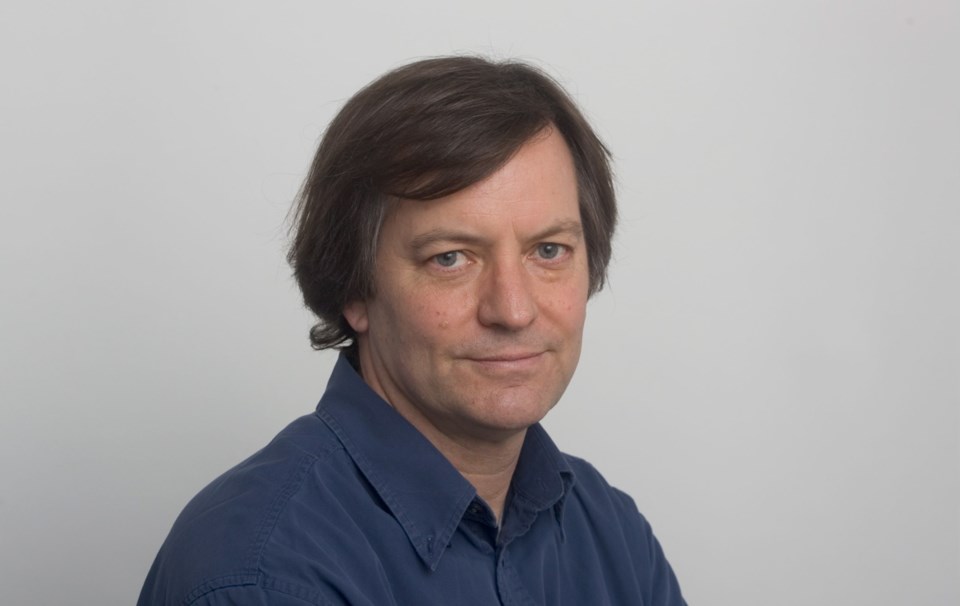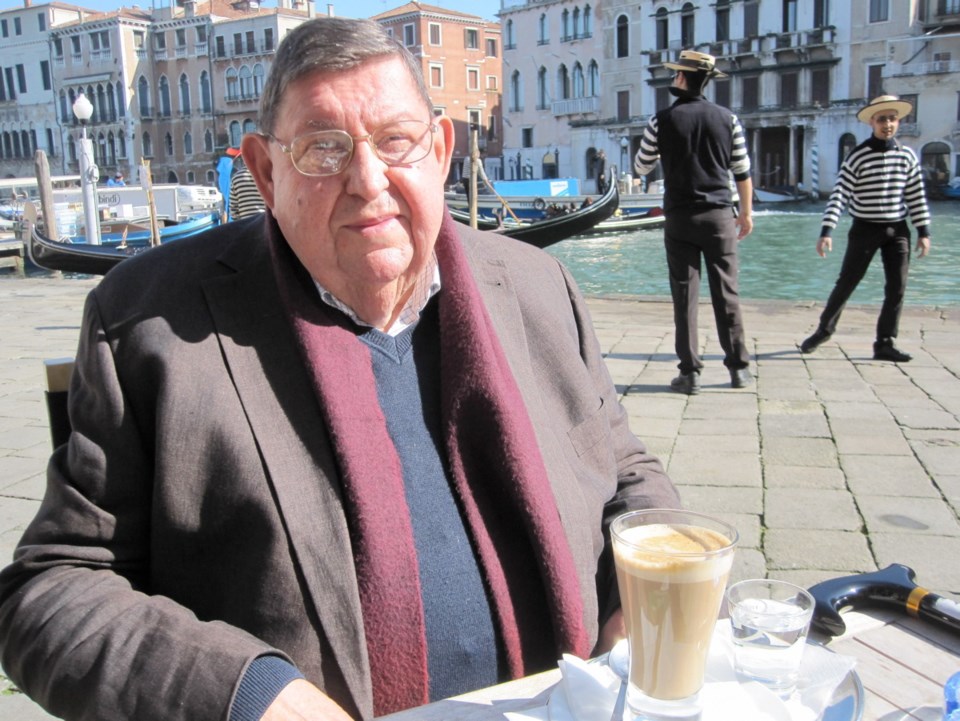 When someone comes back from a wonderful time away, it’s a treat to listen to their travel tales. Michael Morris has just returned from seven weeks in Venice, and when we sat down in the garden of his Brentwood Bay home, he told me all about it.
When someone comes back from a wonderful time away, it’s a treat to listen to their travel tales. Michael Morris has just returned from seven weeks in Venice, and when we sat down in the garden of his Brentwood Bay home, he told me all about it.
Morris is the winner of this year’s Audain Award for the Arts, British Columbia’s most prestigious (and richest) art prize.
“In a way, I’m glad I didn’t have to go to the ceremony,” he sighed. Instead, he sent a representative, and posted a letter and a couple of pictures from Venice.
His residence in Venice was sponsored by the Emily Harvey Foundation and, while there with his partner-in-art Vincent Trasov (a.k.a. Mr. Peanut), Morris did quite a bit of writing in preparation for a big show of the Morris/Trasov Archives scheduled for 2018.
He was clearly glad to be back in Brentwood.
“It’s so green,” he said. “Not 10,000 tourists right in front of your face every time you open the door.”
His apartment was near the Rialto Bridge and the fish market.
“I saw some lovely things, nice surprises, big collections, this, that and the other. The big collections aren’t in Venice, actually,” he told me. “The best of Venetian art was taken away and you find it in the National in London, and at the Met in New York.” The finest Canaletto and Guardi paintings are in the gallery in Dresden.
Yet all is not lost.
“You’ll find a small thing just by surprise, by accident. You’ll come into some typical little palazzo — Venice is filled with them — lots of furniture and glass.
“And all of a sudden a beautiful della Francesca that just like stopped me completely. Across the wall from that was a Boticelli of the Judgment of Paris. It’s a long painting with the three beauties, and Paris with the golden apple. He’s presenting one of them with it, and there it is. There’s nothing else there, just those two wonderful things. It’s lovely to find things like that.”
Morris was there in time for the run-up to the 56th Venice Biennale.
“It’s an interesting Biennale,” he reported, “directed by Okwul Enwelor. It was very anti-marketplace. The artists showing and presenting are not big names, a lot of artists from Asia and Africa.” He mentioned one artist who spent the entire time reading Karl Marx’s Das Kapital to the public.
Venice doesn’t really have much of a contemporary scene. Artists can’t afford to live in Venice anymore.
“It’s all curators that you run into,” Morris observed, “lots of curators around, and lots of shows.” He took in a Cy Twombly retrospective, war paintings by Jenny Holzer, a show of German art from the Weimar period — 1918 to 1933. He especially enjoyed the show at Peggy Guggenheim’s palace.
“Every piece is a masterpiece,” he gushed. “She had Marcel Duchamp to select pieces for her collection. They’re all of that period, wonderful stuff.
“It was nice seeing the [Jackson] Pollocks. I’ve never really seen a lot of Pollocks, but they’ve got a couple of galleries filled with them. That’s an experience, to see the real thing.”
From Venice you can take day trips to Padua, Ravenna and Trieste.
“Things have changed in the 15 years since I was last in Italy,” he reminisced. “Padua has the best Giottos in a chapel there, but now you have to make an appointment, and there is a limit to the number of people at one time. Of course, they are maintaining the treasures, but when I think back to the access we took for granted, I realize now how spoiled we were.”
Toward the end of his stay, Ruth Wittenburg, president of the board of the Art Gallery of Greater Victoria, arrived for a 10-day cooking course with her friend Jackie Hamilton. Also on hand from Victoria was the gallery’s chief curator, Michelle Jacques.
“She has been to biennales before,” Morris reminded me. “Twenty years ago, when she started at the Art Gallery of Ontario, she was there assisting Jessica Bradley. They were in charge of a film in which Rodney Graham, dressed like an 18th-century pirate, had fallen asleep under a palm tree. And a coconut fell on his head. Michelle was the assistant and had to run all over the place looking for things — it was her first time in Venice.”
This year, she was accompanied by Haema Sivanesan, a new curator who has just taken up a position in Victoria.
“It was nice in that sense of being right away from things,” Morris mused, “but I missed the seasons going by. In Venice you are not aware of that. The whole place is stone — not a blade of grass anywhere. Because it floods with salt water, you can’t plant trees. There are only pigeons and gulls, no bird song anywhere.”
He contented himself with buying big bunches of flowers from the market to brighten up his room, which, being on a narrow passageway, was dark even at midday.
Morris is 74, and had a few difficult years health-wise, but he has blossomed in 2015.
“Yes, for sure it’s turning out to be a good year,” he concluded. “Apart from getting a cold when I got home, I’m just now getting the garage cleaned up [for use as a studio], and getting ready to get some work done.”
In addition to the planned 2018 retrospective, he hopes to be part of the next Venice Biennale, perhaps showing with Attila Richard Lucaks and Lawrence Paul.
See you there.



